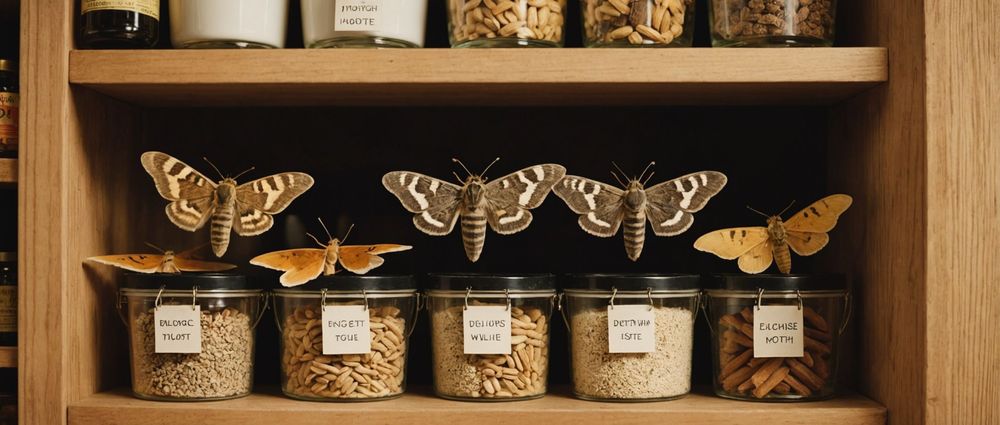Moth traps can be an effective solution for controlling moth populations in your home, but their effectiveness often depends on various factors, including the type of traps used and the nature of the moth problem. These traps are designed to capture adult moths, thereby interrupting their lifecycle. This article delves into the mechanics of moth traps, exploring how they work, their effectiveness, and tips for maximizing their use in your pest control strategy.
Understanding Moth Traps
Moth traps are devices specifically aimed at attracting and capturing adult moths, preventing them from reproducing. They typically employ scents or pheromones that lure moths into a sticky pad or container. Here’s how they generally work:
- Attracting Pheromones: Many traps utilize species-specific pheromones that mimic the scent produced by female moths, attracting males looking to mate.
- Sticky Surface: Once attracted, the moths land on a sticky surface where they become trapped, preventing them from escaping.
- Monitoring Population: Some traps also serve a dual purpose by allowing homeowners to monitor moth activity and determine the extent of an infestation.
There are several types of moth traps available including pheromone traps, light traps, and UV traps. Each type targets different species of moths and can be used based on the specific problem being faced.
Effectiveness of Moth Traps

The effectiveness of moth traps primarily hinges on consistent usage and understanding when and where to apply them. Here are some key points regarding their efficacy:
- Species Specificity: Different traps target specific types of moths, so it’s crucial to select the correct trap based on the moth species you are dealing with, such as pantry moths or clothing moths.
- Early Intervention: Moth traps are most effective when used at the onset of an infestation. The sooner you deploy them, the more moths you can capture before they reproduce.
- Placement: Proper placement is essential. Traps should be positioned near infested areas, such as pantries or closets, to increase the likelihood of capturing adult moths.
- Regular Monitoring: Frequent checks on the traps will help gauge moth activity and may indicate the need for further actions like cleaning or using pesticides.
While moth traps are useful, they should be used as part of a comprehensive pest management plan that includes cleaning, sealing entry points, and possibly using insecticides if necessary.
Pros and Cons of Moth Traps
As with any pest control method, moth traps come with their advantages and disadvantages. Understanding these can help homeowners make informed decisions:
Pros:
- Non-Toxic: Moth traps typically use non-toxic materials, making them safe for indoor use around pets and children.
- Easy to Use: Most traps require minimal setup and can be replaced easily without any complicated procedures.
- Effective Monitoring: They provide valuable insights into the level of moth activity in your home, aiding in more comprehensive control strategies.
Cons:
- Limited Scope: Traps capture adult moths but may not address larval infestations already present in clothing, food, or fabric.
- Species Limitations: Traps designed for specific moth types may not be effective against other species, limiting their overall utility.
- Short Lifespan: Adhesives can become less effective over time, necessitating regular replacement for continued efficiency.
Tips for Using Moth Traps Effectively

To maximize the effectiveness of moth traps in your home, consider the following tips:
- Choose the Right Trap: Research the specific species of moth you’re dealing with and select traps designed for them.
- Strategic Placement: Identify hotspots where you’ve noticed moth activity, and place your traps in those areas to enhance their effectiveness.
- Regular Replacement: Ensure that you change traps consistently as per the manufacturer’s guidelines to maintain their adhesive properties.
- Complementary Measures: Combine traps with cleaning practices, such as vacuuming closets and sealing food items, to tackle the problem holistically.
- Monitor and Adjust: Keep an eye on the traps and look for changes in moth capture rates. If they don’t seem to be working, reassess your strategy.
Conclusion
Overall, moth traps can be a beneficial component of a pest control strategy if used correctly. They are most effective for monitoring and controlling adult moth populations when paired with comprehensive cleaning and preventive measures. Although they may not resolve all moth-related issues, their role in reducing adult moth numbers can significantly hinder the lifecycle of these pests, making your home less appealing for them. Therefore, investing time in selecting the right traps, placing them strategically, and combining their use with other control methods will yield the best results in managing moth infestations.
FAQs
1. Are moth traps safe to use around pets and children?
Yes, most moth traps are non-toxic and safe to use around pets and children. However, always check the product labels for specific safety instructions.
2. How often should I replace moth traps?
Moth traps should typically be replaced every one to three months, or sooner if they are filled with moths or lose their adhesive quality.
3. Can moth traps get rid of all types of moths?
No, each trap is designed for specific moth species. Make sure to choose a trap that targets the particular type of moth you have in your home.
4. What should I do if moth traps don’t seem to be working?
If moth traps are not effective, consider checking for larvae in clothing or food items and combining your efforts with cleaning and sealing methods to eliminate the source of infestation.
5. Where is the best place to put moth traps?
Place moth traps in areas where you have noticed moth activity, such as closets, pantries, and near windows or doors where they may enter your home.
